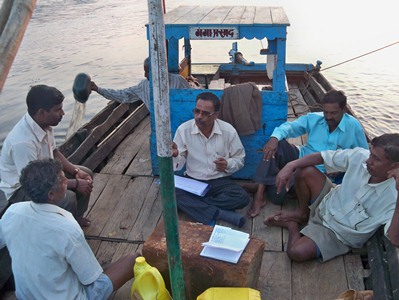Working towards inclusive and sustainable socio-economic
development...
Resources
Success Stories >>
> Women Leadership -Exploring New Horizons
> Dakshata Samities - A Countervailing Power to Corruption >>
> Hearing People's Voice - Multi Stakeholders Dialogue
> Fight for Justice - Women Federation Enforced Re-execution of 'National Health Insurance Scheme'
> Revolving Fund - Marching Towards Economic Security
> Bringing Technology to Grssroots - Reverse Osmosis Water Treatment Unit
Resources > Success Stories > Countervailing Power to Corruption >
Countervailing Power to Corruption...

In India, the 73rd constitutional amendment decentralized powers to local self-governing institutions & brought the Right to Information Act, which have created avenues for more transparent village governance. There are two important systems here; Gram Panchayat (GP-body of elected representatives) & battery of officers appointed at village level. The Indian rural society being largely feudal in nature 'class', 'caste' & 'patriarchy' structures authorize governance systems, hence the systems function in an opaque & unaccountable manner. Such approach has led to rampant industrialization in Lote industrial area, an ecologically fragile zone in Ratnagiri district. It has damaged the local eco system, eroded traditional livelihoods & quadrupled diseases. To tackle this Parivartan developed concept of village level citizen organizations to demand accountability & audit functioning of the governance mechanisms.
Parivartan introduced vigilance committees of citizens called Dakshata Samitis (DS). The DS operates as structures of 'countervailing power' to balance the 'official power' in governance that is often prone to corruption. DS exemplifies mechanism for establishing the delicate balance & partnership between civil society & state.
Organizing DS
1. The concept of DS is discussed & decision to form DS is made in Gramsabha.
2. Each hamlet/Wadi Sabha nominates two persons, a male & a female to the DS, through consensus instead of secret ballot, preventing factionalism.
3. With the candidates from each hamlet, DS with minimum 11 members is formed at the village level. They are not formally registered albeit they function on the basis of written code of conduct.
Through creative tools like 'Multi Stakeholder Dialogue' (MSD) & 'Community Livelihood Manifesto' (CLM), DSs have been successful in making the industrialization pro-people with greater liability in environmental planning & also in governance systems thus assuring efficient flow of public services & goods to villages.
Innovation
Since, DS has members from all caste & class groups, it represents interests of all the sub-groups in a village. The DS members can be recalled for non-performance at the hamlet/village meeting. The DS meets at least once in a month & presents activity report thrice a year to village. Parivartan gives training to DS members, but the real capability building has been achieved through actual work experience & handholding by the activists of Parivartan. DS engages with the local governance machinery as a 'partner' in developing processes & programs that are pro-poor and pro-community.
This approach was clearly demonstrated with DS's intervention on Industrialization; while most environmental movements of people have been confrontational & opposed to industries & businesses, Parivartan with DS has operated from the position of collaboration and dialogue. Typically, a DS is formed on the foundation of trust & consensus. Village communities nominate citizens with high ethical fiber, integrity & a track record of leading public actions and give them moral legitimacy to operate as watch dogs of governance. Hence, DS acts as the most powerful check on GP members so as to restrict them in getting engage in corrupt practices. This increases the confidence of the underprivileged in DS. This, in turn deepens the accountability of DS to serve as clean conduits of dialogue & action between the state & community. Slowly, the DS becomes a strong countervailing power center to the village council. DS functions effectively in small rural communities due to 'the proximity effect'; they are more accessible, enabling direct flow of information & monitoring of each other. The 'power' to the DS is not its 'official' status flowing from the power of the state, but power of 'morality'. The members claim this morality by simply behaving the notions of right & wrong embedded in collective consciousness of the community. The members of the DS try to manifest this morality in their public affairs.
Delivery Model
At times, the GP & bureaucracy do try to disrupt the DS. In such instances, the DS has always gone back to people where issues are resolved only based on the principle of 'upholding the common good'. On this forum resorting to corrupt practices to promote parochial class & caste interest is very difficult as it stands exposed in the people's assembly. This is how corruption is controlled by the mechanism of DS promoting a culture of good governance.
Effectiveness
Since 8 years DSs have acted as an effective mechanism to ensure transparency & accountability to prevent corruption & force the government to adopt the just practices. The exemplary outcome of the DS was that, they were able to hold the GP members to account & ensure proper conduct of the Gramsabhas as stipulated by law. The village accounts & budgets were submitted to & ratified by Gramsabha. There are few such villages in the country.
To summarize, Dakshata Samitis has considerably enhanced the decision making abilities of villagers using their indigenous intellect, as now they have the mechanism to oppose the ill intended bureaucratic decisions.